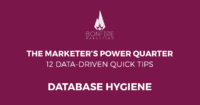There remains one reliable, inevitable constant across every role in any industry: the need for data. Whether you’re monitoring engagement on social media, mining for insights about population health, or arguing over the best player of your favorite sport, strong data is key to crafting insights.
The problem is, it’s easy to ask big questions of data, but can be overwhelming when you find yourself in the thick of it, pulling data from multiple sources and compiling endless spreadsheets. Your audience might be similarly overwhelmed when presented with this complex data. So, how do you stay sane while providing meaningful, understandable insights? Use a classic marketing strategy: Make the data tell a story.
Why a story? Presenting data as a narrative gives it an emotional, engaging connection. Data that is personalized in this way is more memorable, relatable, and compelling for your audience.
Here are three tips to help your data read like Dante and your stats flow like Shakespeare:
Flesh out a narrative
Like all good stories, a data story needs to have a narrative. Simply presenting someone with a wall of numbers is not going to be easy to follow or understand. A logical, flowing story provides perspective. It’s easy to spend a week in the depths of a spreadsheet and lose sight of what it might look like to someone who is not as familiar with the data.
Compelling, in-focus data is credible data. When you’ve explained your thought process, your actual process, and your insights in a form your audience can relate to, questions about the validity of your data and methods disappear.
Start by taking a bird’s-eye view of the issue. What is the actual question you are trying to answer? The facts and data represent the what, but don’t fail to consider the who, how, and why, or you might end up answering a question that doesn’t make sense. Take note of the crucial thesis of your work, and then revisit it regularly!
As you develop your narrative, consider the audience. Is it an expert who is strongly familiar with the data? They need the unabridged version of the story. Is it an executive who only needs significant takeaways? Give them the CliffsNotes. Maybe you’re dealing with multiple stakeholders, in which case you’ll need to develop a few different versions of the final story. Matching the messaging to the audience will make everyone’s life easier.
Get comfortable with the mess
Perhaps you remember taking a metrics course in school where you were asked to slice up data and build graphs and charts. Remember how nice it all looked? Now forget all that. In the real world, data is messy. When data comes over long timelines and from mismatched data sources, it only gets messier.
That’s OK! Embrace the mess. When data gets messy, there is often no universal fix, but it is important to remember not to obfuscate the specific challenges. Instead, take note of data issues and use them in your story.
Use your words
Simply presenting numbers and charts is not enough to tell your compelling story. Individuals learn and retain information differently, and summarizing your information and insights with supplementary qualitative observations gives the audience a variety of visual cues to follow.
This is another opportunity to know your audience. Think back to the big-picture perspective. What are the questions you are asking? Answer them qualitatively and quantitatively. Use examples and humor (if appropriate) to drive your point home.
Related resources:
More Content
How to Create Personas With Google Analytics
Personas are critical for the success of your marketing efforts, digital or not. Strong personas are a reference for every department in your company or agency — from strategy to
The Marketer’s Power Quarter: Updating Lead Databases
This is the tenth in a 12-part series of quick-fix tips to improve your digital marketing results. Catch up on our last tip, and subscribe to our newsletter to get the
AI in Marketing: How to Get Started in 2018
One of the biggest buzzwords in marketing, and really across many industries, is artificial intelligence. For years, a majority of the public viewed AI as science fiction, but that’s starting




Leave A Comment